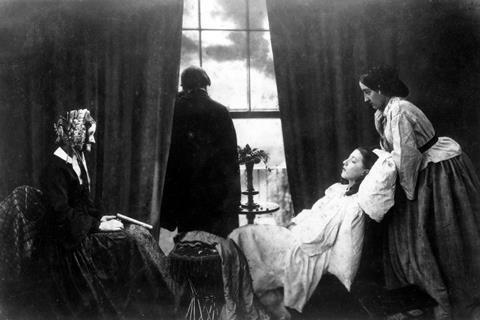What was draining the life out of 18th and 19th century New Englanders?

Discovering an old skeleton with the skull and femora in a skull-and-crossbones arrangement would have had many thinking of the Jolly Roger flag and the Golden Age of Piracy. This skeleton’s last resting place was not a pirate’s Caribbean hideout, but an unmarked cemetery in Griswold, Connecticut dating back to the 18th and 19th centuries. Excavated in 1990 after a group of children playing in a gravel quarry stumbled across remains, the cemetery contained over two dozen burials that were fairly unremarkable – save one. That one re-arranged skeleton was determined to be a middle-aged man likely considered far more dangerous than a pirate.1 A vampire.
He was not the only one.
In the mid-1800s, the Ray family of Jewett City – an area now part of Griswold – was thought to be both victim and perpetrator of vampirism. The family’s patriarch and his two sons were struck down with a lethal wasting illness. When a third son was struck ill, some loved ones and neighbours feared the departed family members were stalking their living relatives. A ‘final effort to save the living’ was made. The bodies of the deceased sons were exhumed and burned. The Ray family became known as the Vampires of Jewett City.
Historical sleuthing and scientific advances would later show the Ray family were no more vampires than the middle-aged man whose remains ended up in a skull-and-crossbones orientation nearby. Like a host of New Englanders – alive and dead – they were caught up what became known as the New England vampire panic.
The panic took hold roughly two centuries after a witch hysteria had swept through the region. While the reasons behind the witchcraft panic seem to involve a complex brew including theology, folklore and misogyny, the fear of vampires correlates best with an all-too-real killer stalking the region. The predator was called consumption at the time; we now know it as tuberculosis (TB). Caused by a bacteria dubbed Mycobacterium tuberculosis, this lung-attacking disease is well understood today, with global education and vaccination programs designed to eradicate it. Symptoms include weight loss, fever, night sweats, grey or pale skin, and a tell-tale bloody, hacking cough.
When the vampire panics flared it was not commonly known that TB spreads through the air, infecting entire families and whole communities. With loved ones and neighbours wasting away, as Rhode Island folklorist Michael Bell has said, ‘it seemed like something was draining the life and blood out of somebody’. Back then, that ‘something’ was feared to be a vampire. Such fears spurred actions like deviant burials.
Deviant burials point out who was denied a normal burial due to something that their community or culture saw as unusual or troubling during their life or death.2 Such burials in Eastern and Southeastern Europe during the medieval period – which included the lifespan of Vlad the Impaler, a Romanian prince rumoured to have inspired the novel Dracula – share something in common: they are commonly associated with vampires.3 Off-norm burials to combat vampirism – including disinterments and reburials – occurred in New England within the modern era. This is posited to be how the middle-aged Giswold man’s coffin was broken into and the body rearranged a handful of years after his death.
Identifying JB
Brass tacks across the lid of the battered coffin spelled ‘JB55’, possibly the initials and age of the deceased and how he came to be referred to by the interdisciplinary team of experts – including the Connecticut state archaeologist – that probed the man’s death and life after his 1990 excavation. His death was likely due to TB, with lesions on the lung-side rib surfaces indicating a chronic lung infection pointing to the dreaded wasting illness.
When the remains of JB55 were first evaluated, DNA profiling was revolutionising criminal investigations but was not advanced enough to tackle the challenges presented by historical samples. Knowing that the future may bring the DNA technology required, the team working JB55’s case planned for tomorrow’s breakthroughs by carefully storing and preserving the remains of JB55 and the other burials with the aid of the US National Museum of Health and Medicine.
Nearly 30 years later, DNA analysis of femoral samples by the US Armed Forces Medical Examiner System’s Armed Forces DNA Identification Laboratory offered critical clues to JB55’s identity.1 Careful analysis of DNA results, historical records and a publicly accessible genetic genealogy website led researchers to tentatively identify JB55 as John Barber. He was likely a farmer who died of a disease that in his time was ’the leading cause of mortality throughout the Northeast, responsible for almost a quarter of all deaths’.
The nature of his death once marked him as an otherworldly monster to be treated outside the norm. Research and technology advances show he was all too human, likely brought down by a monstrous disease that still kills over 1.5 million people each year. Abolishing this disease features in a United Nations Sustainable Development Goal and the World Health Organization has detailed a strategy to end TB. This is a foe we can vanquish. But we will do that through public health activities, not by rearranging the skeletons of the dead.
References
1 J Daniels-Higginbotham et al, Genes, 2019, 10, 639 (DOI: 10.3390/genes10090636)
2 L A Gregoricka et al, PLOS One, 2014, 9, e113564 (DOI: 10.1371/journal.pone.0113564)
3 A Alterauge et al, PLOS One, 2020, 15, e0238439 (DOI: 10.1371/journal.pone.0238439)

















No comments yet